On a Saturday soon after we arrived in Savannah we decided to visit this
historic site, which was part of one of the original plantations in the
area. We enjoyed the scenic drive back to the main area of the site, the
early Georgia history we learned, and the exercise we got walking along
the trails.This is the impressive arched stone entrance to Wormsloe:
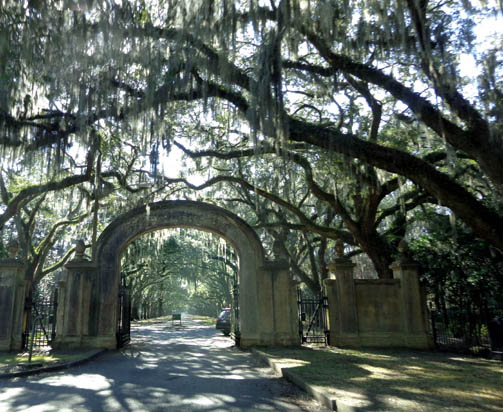
Two dates are engraved in the stone: 1733, when Noble Jones arrived in
Savannah, and 1913, the year the arch was erected.
Just inside the gate our first stop was at the superintendent's
cottage, which housed various families from 1917 to 1990.
Some would oversee the maintenance of the estate and some worked in the
dairy that operated half a mile down the avenue from about 1910 to 1940:
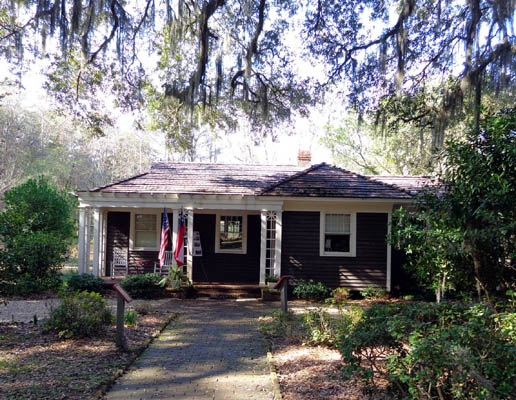
Now the building is the entrance station where visitors pay their entry
fee ($10 per person or $9 senior/military rate) and begin learning about the
history of the plantation.
Then we were treated to the picturesque, tree-lined 1½-mile long
roadway named Oak Avenue back to the parking area for the visitor
center/museum, tabby ruins, gravesite, colonial life area, trails, and
an observation
deck over the marshes:
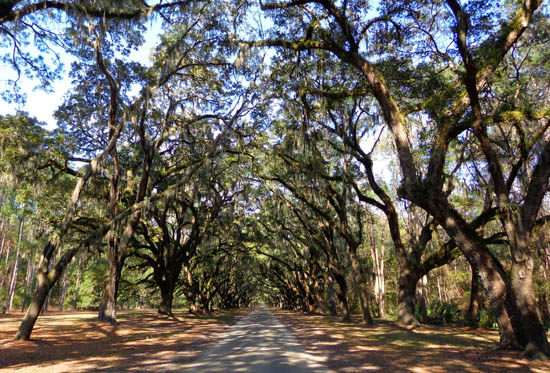
While scanning the information we picked up about the area at the
Savannah visitor center I saw a photo of the huge live oaks along this beautiful
road. It was one of the reasons I wanted to go to Wormsloe.
Honestly, I
was just as interested in the scenic drive back to the main part of the
historic site as I was in seeing what was back there!
Four hundred of these now-large trees were planted along the avenue
in the late 1890s by one of Jones' heirs. It is such a treat to drive
under their twisted branches loaded with Spanish moss for over a mile
and back again. Some of the live oaks at Bonaventure Cemetery are 250+
years old so these should have many good years ahead of them.
WHO WAS NOBLE JONES?
To fully appreciate the photos in this entry I need to share a bit of the history
of the place. This information is from the two brochures we got at the entrance.
Wormsloe began as the colonial estate constructed by Noble Jones, one
of Georgia's first settlers. Jones was one of the 114 English
colonists who came to the Savannah area in 1733 with James Oglethorpe.
His wife, daughter, and oldest son also came with him.
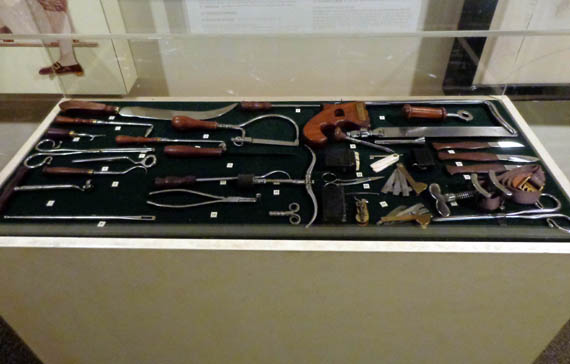
18th century medical instruments
like the ones used by Noble Jones and his son,
Noble W. Jones; these are
on display in the museum at the Wormsloe visitor center.
In England, Jones was a physician, surveyor, and carpenter. He
learned even more skills in the Georgia wilderness and became quite indispensable
to the young colony.
He commanded a company of marines charged with
Georgia's coastal defense, served as constable and Indian agent, laid
out the towns of Augusta and New Ebenezer, was a member of the Royal
Council, and held a variety of other public posts in the new colony.
As one of the historic site brochures states, "Perhaps most importantly, he was
one of the few original settlers to survive hunger, plague, Indians,
Spaniards, and a new environment."
So did his family, for whom he built a tabby house overlooking the
major water route that ran past his property. He was so busy with other
jobs that it took him until 1745 to complete the house, which was
fortified by a wall with bastions at the four corners:
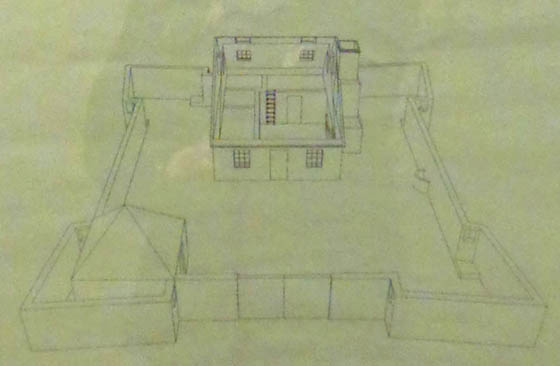
Artist's sketch of Jones'
fortified house, from an interpretive display in the visitor center
In the early years the family cleared about 14 acres of land to raise cattle
and plant vegetables, fruit, fruit trees, and mulberry trees for silk.
Jones leased 500 acres on the Isle of Hope from the
colony's Trustees in 1736. Twenty years later he received a royal grant
conveying ownership of the property to him. The land (and more acquired
through the years) remained in his heirs' hands until 1972, when his
descendants donated 822 acres to the Nature Conservancy. That
organization sold the property to the state of Georgia the next year.
About 80 acres of the original plantation, including a house built in
1828, are still owned by descendants of Noble Jones. Visitors pass that
property on the way back to the visitor center and ruins of the original tabby house.
PHOTOS FROM THE
VISITOR CENTER & MUSEUM
After enjoying the
peaceful drive back to the visitor center we
found a nice, shady spot to park under the sprawling oak trees.
We had both dogs with us in the truck. Dogs other than service animals
aren't allowed inside the visitor center but they are permitted on-leash
throughout the rest of the historic site. Although it was shady, the
Savannah area set a new record high for that mid-January date (81 F.) so we couldn't
spend more than a few minutes inside the building, even with four windows
cracked a couple inches and water available in the truck for them to drink
if they got thirsty while waiting for us.
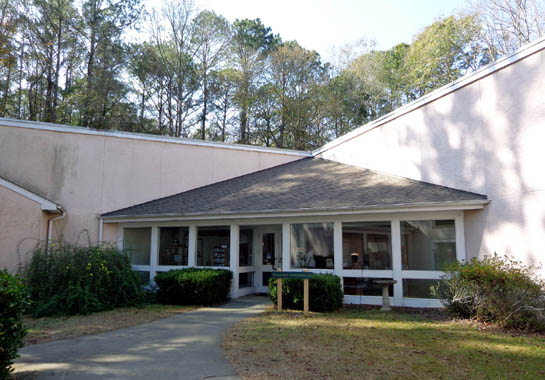
Once inside the visitor center we watched a short video about the
founding of the 13th colony and the family that has owned this
plantation since the early1730s.
We quickly browsed the historical artifacts and exhibits in the museum,
then went back outside to get Casey and Cody.
WORMSLOE'S TABBY RUINS & GRAVESITE
We took the dogs with us on the shaded, sandy, one-mile trail around the
grounds, visiting the site of the original tabby house, a grave, an observation deck over the
marsh, and two living history areas.
The fortified tabby house was surrounded by eight-foot high walls to
protect Jones' family from attacks by the Spanish and their Indian
allies in the 1730s and '40s. Only a few of the walls remain today:
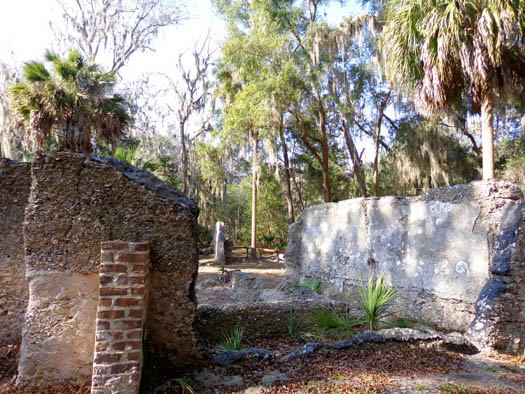
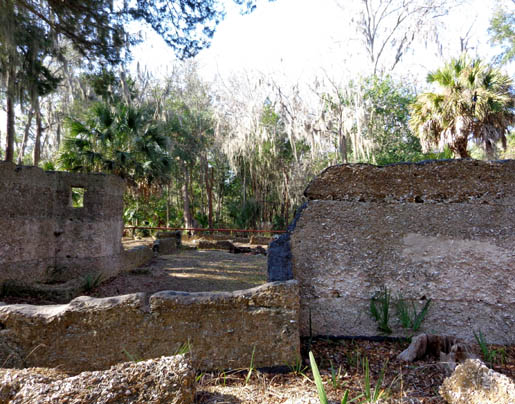
Tabby is made from four materials found in abundance along coastal
Georgia and Florida -- lime, sand, oyster shells, and water.
After mixed, the wet ingredients were poured into wooden molds to
solidify for several days like concrete. When the mixture was set, the
molds were removed and reassembled on top of the hardened tabby and
another layer was poured.
This display in the museum describes how tabby was made:
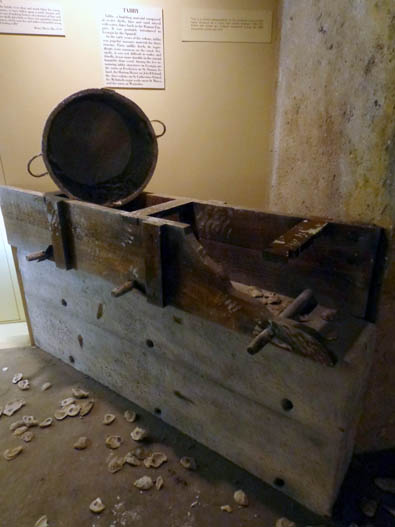
The original house was 1½ stories high
and contained five rooms, making it one of the largest dwellings in the
Savannah area at the time.
A trail leads past the
wetlands to the original family burial site:
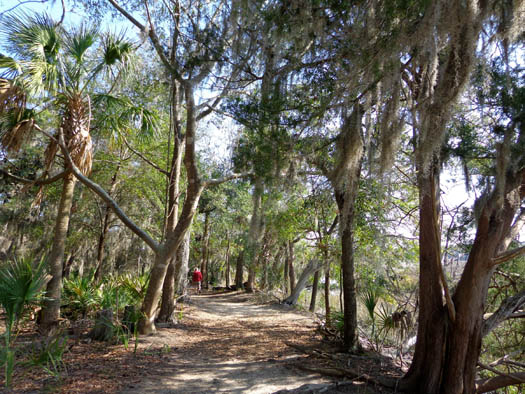
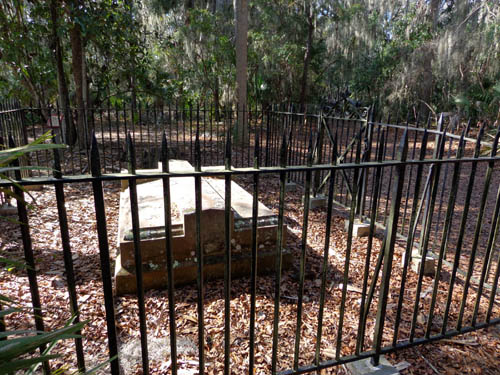
Noble Jones was buried there in 1775
next to his wife and later, one of his sons.
No one is buried there now. Sometime in the 1800s
his
great-grandson, George Wymberley Jones De Renne, had his ancestors' remains
moved to Bonaventure Cemetery. In 1875 he had this stone monument placed
at the gravesite.
COLONIAL LIFE & LIVING HISTORY AREAS
Farther along the loop trail we came to the Colonial Life Area with
examples of 18th Century tools and a
replica of the small wattle-and-daub huts used as quarters for Jones'
marines, indentured servants, and slaves:
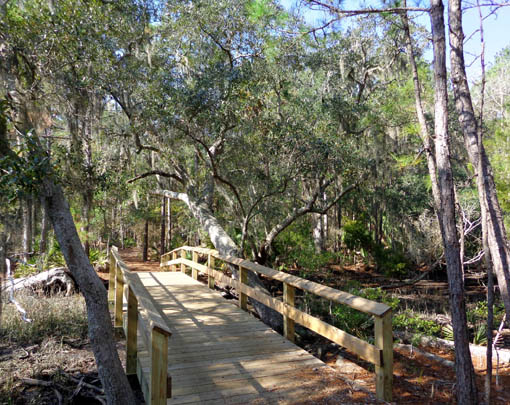
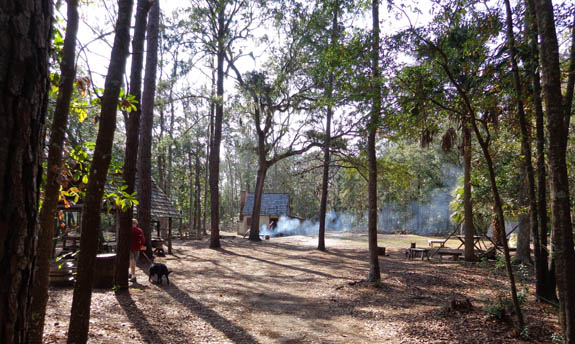
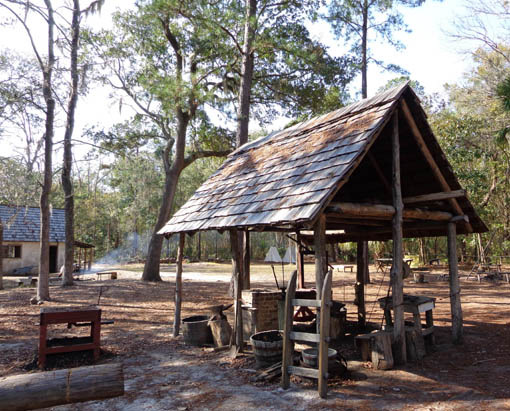
We got there about noon, between two living history presentations.
It was interesting to see one of the re-enactors cooking his own lunch over the fire
he used in his demonstrations!
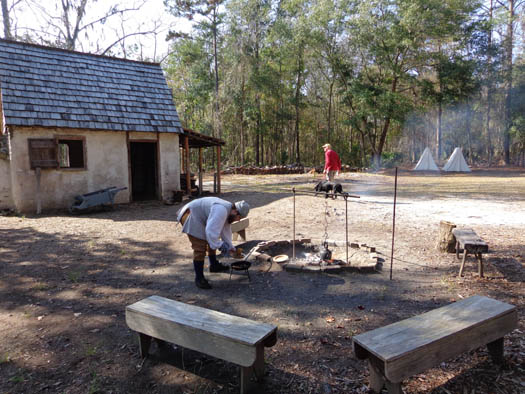
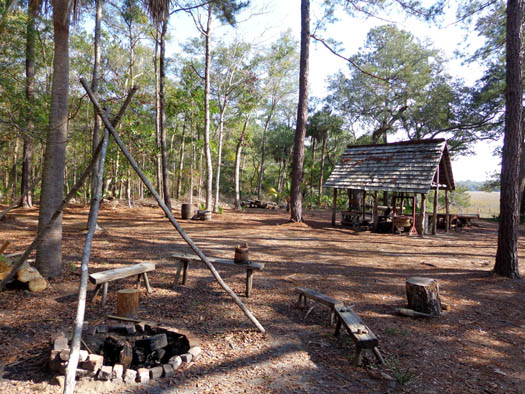
The little house has only one room, a sleeping loft, and a chimney
for cooking and heating:
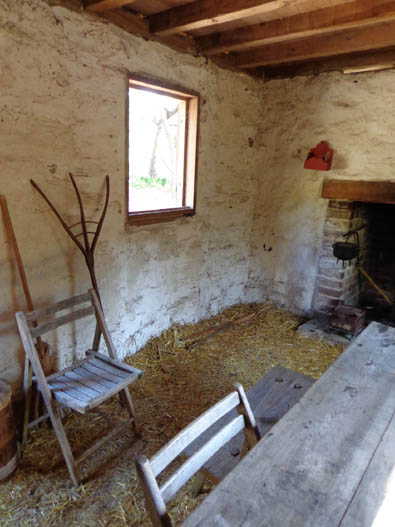
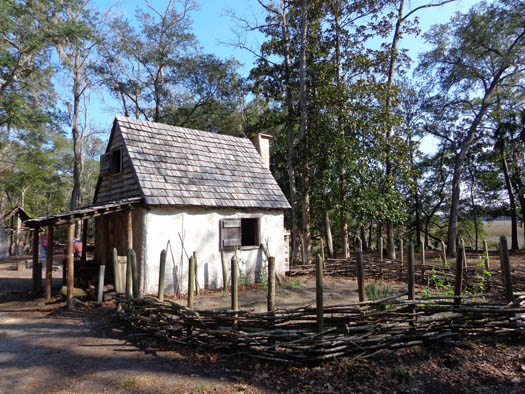
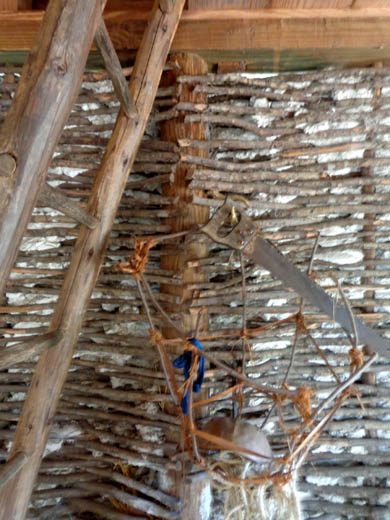
Wall with "wattle"
A nearby interpretive panel showed sketches of various
tools and the construction of walls made with wattle and daub:
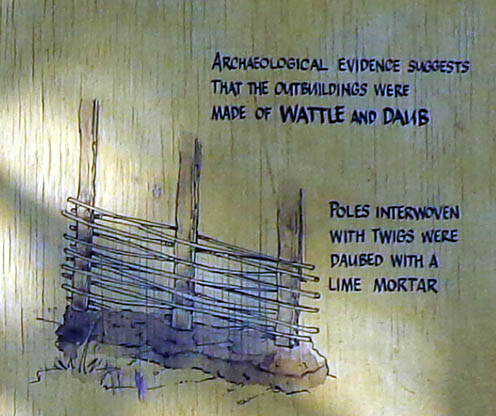
Other nearby structures include primitive covered shelters similar to
what the early Georgia settlers would have used:
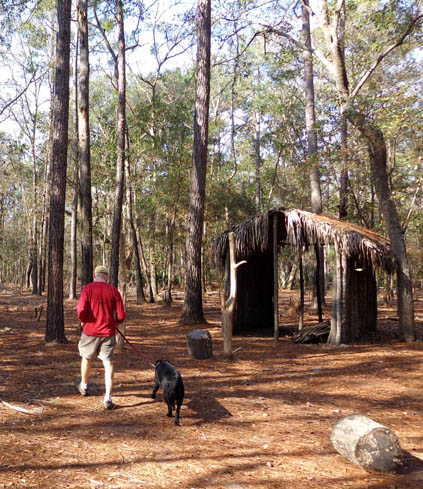
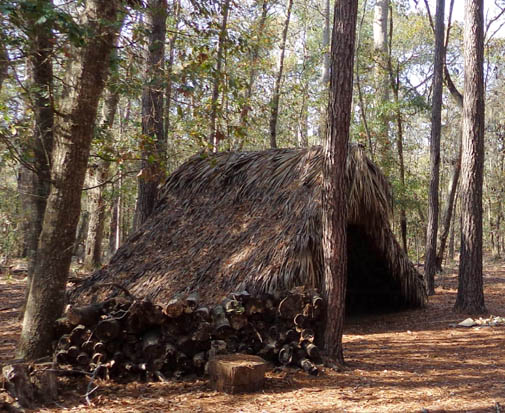
We missed the four living history presentations that day at 10,11,2, and
3. It was just too hot and humid to hang around any longer, even though
we were mostly in the shade.
For the same reason we didn't try to hike the three-mile Battery Trail
loop either. It's probably similar to the shorter loop we walked:

Much of the plantation reverted to a long-leaf pine forest by the mid-1900s.
If you're interested in more historical details about the Jones
family and Wormsloe from 1733 to the present day you can read more about
them on
Wikipedia, which surprisingly has more
information than the official Wormsloe web
page.
Better yet, go see the place for yourself the next time you're in
Georgia . . .
Next entry: more local history at Fort Pulaski
Happy trails,
Sue
"Runtrails & Company" - Sue Norwood, Jim O'Neil,
Cody the ultra Lab, and Casey-pup
Previous
Next
© 2013 Sue Norwood and Jim O'Neil























